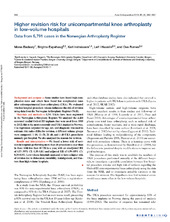Higher revision risk for unicompartmental knee arthroplasty in low-volume hospitals
Peer reviewed, Journal article
Published version

Åpne
Permanent lenke
https://hdl.handle.net/1956/10445Utgivelsesdato
2014Metadata
Vis full innførselSamlinger
Originalversjon
https://doi.org/10.3109/17453674.2014.920990Sammendrag
Background and purpose — Some studies have found high complication rates and others have found low complication rates after unicompartmental knee arthroplasty (UKA). We evaluated whether hospital procedure volume influences the risk of revision using data from the Norwegian Arthroplasty Register (NAR). Materials and methods — 5,791 UKAs have been registered in the Norwegian Arthroplasty Register. We analyzed the 4,460 cemented medial Oxford III implants that were used from 1999 to 2012; this is the most commonly used UKA implant in Norway. Cox regression (adjusted for age, sex, and diagnosis) was used to estimate risk ratios (RRs) for revision. 4 different volume groups were compared: 1–10, 11–20, 21–40, and > 40 UKA procedures annually per hospital. We also analyzed the reasons for revision. Results and interpretation — We found a lower risk of revision in hospitals performing more than 40 procedures a year than in those with less than 10 UKAs a year, with an unadjusted RR of 0.53 (95% CI: 0.35–0.81) and adjusted RR of 0.59 (95% CI: 0.39–0.90). Low-volume hospitals appeared to have a higher risk of revision due to dislocation, instability, malalignment, and fracture than high-volume hospitals.
